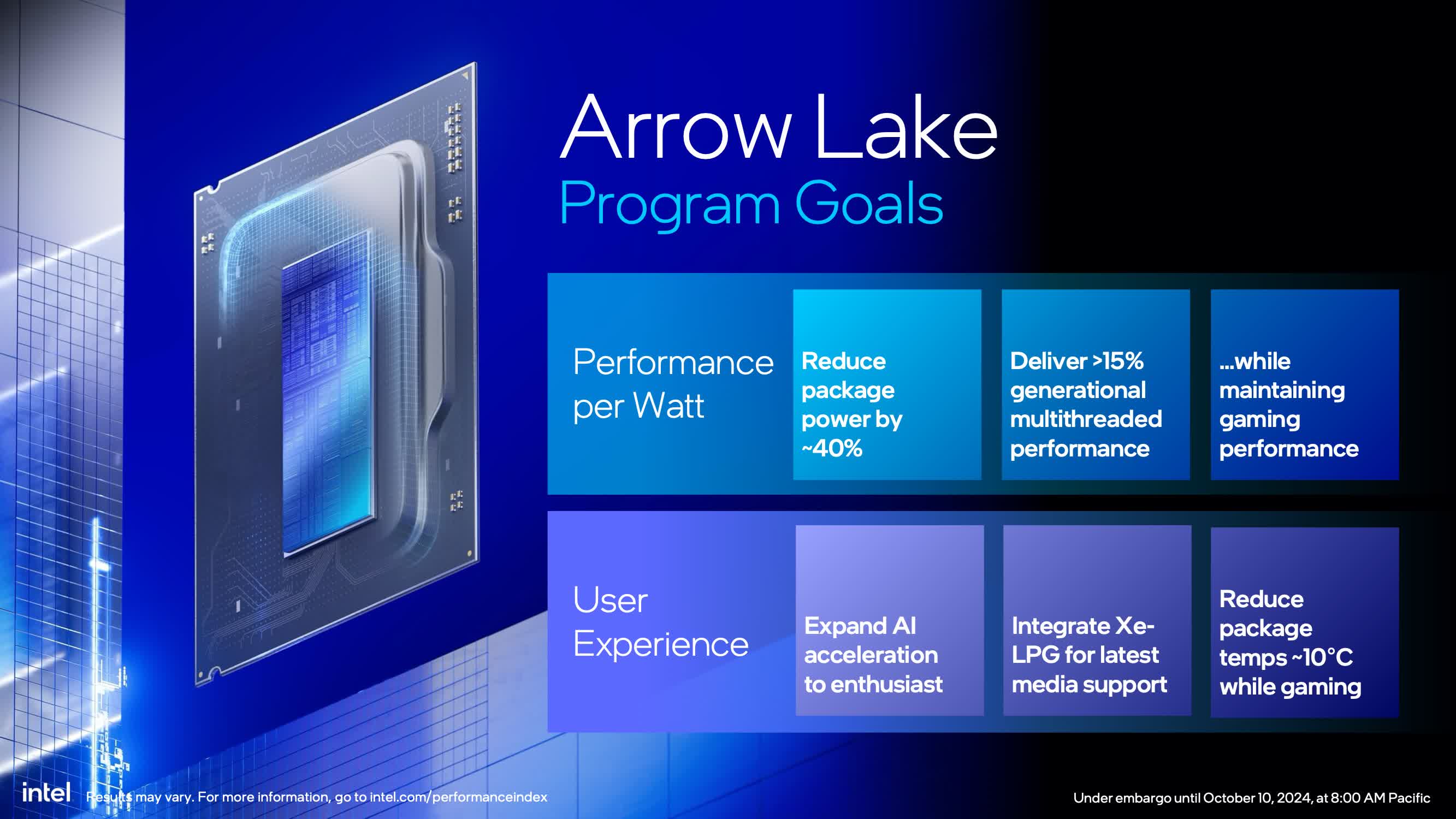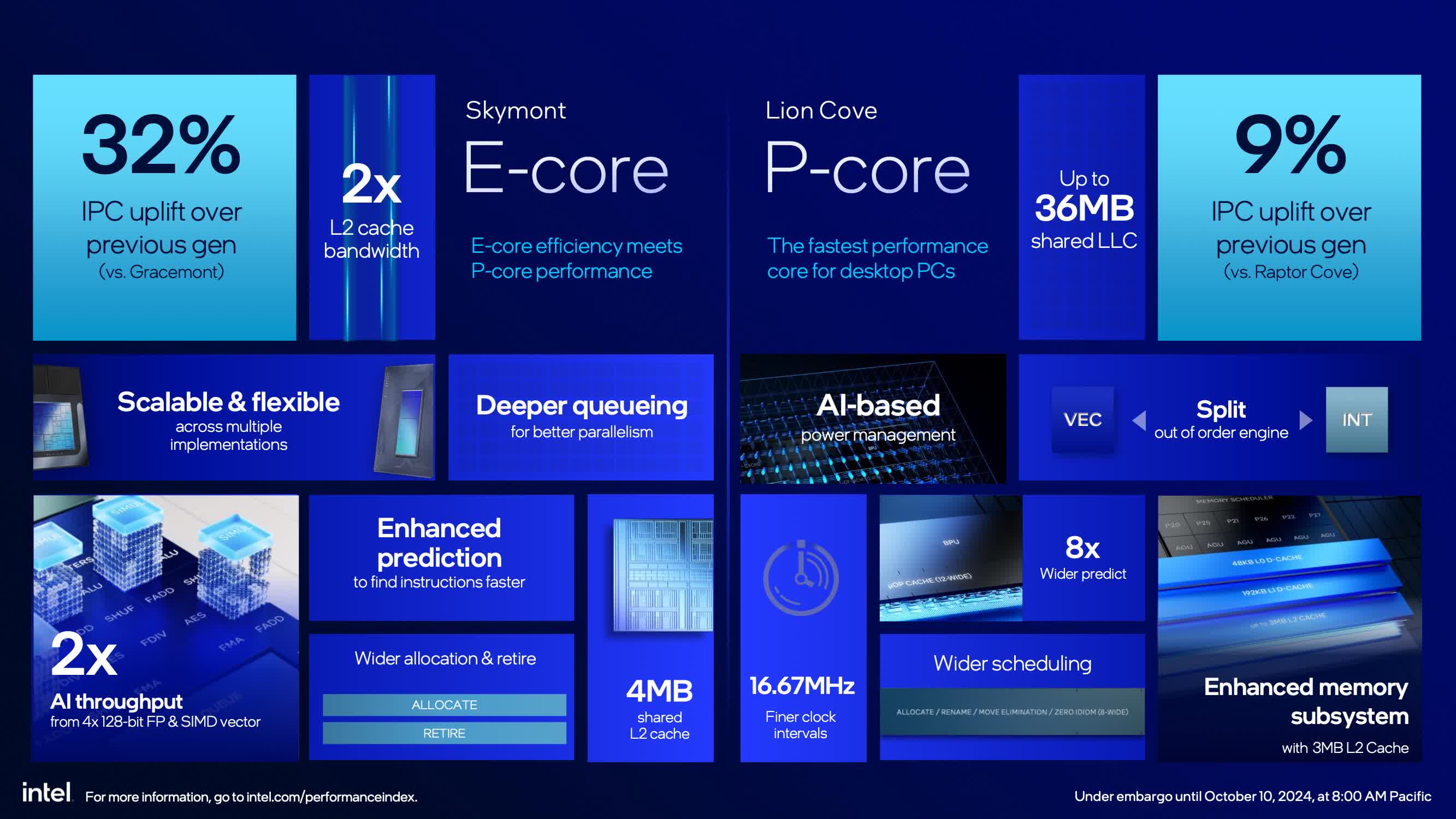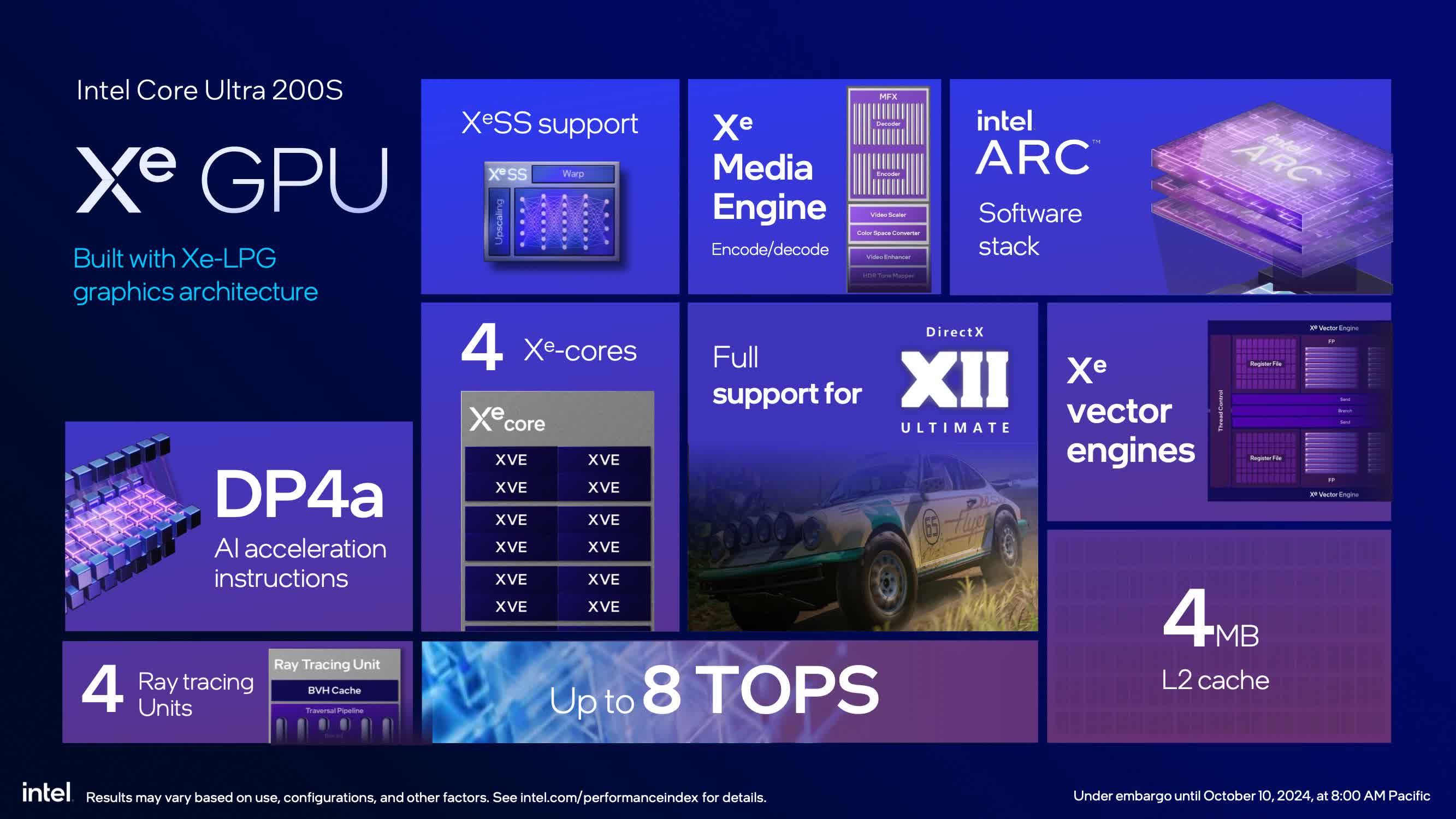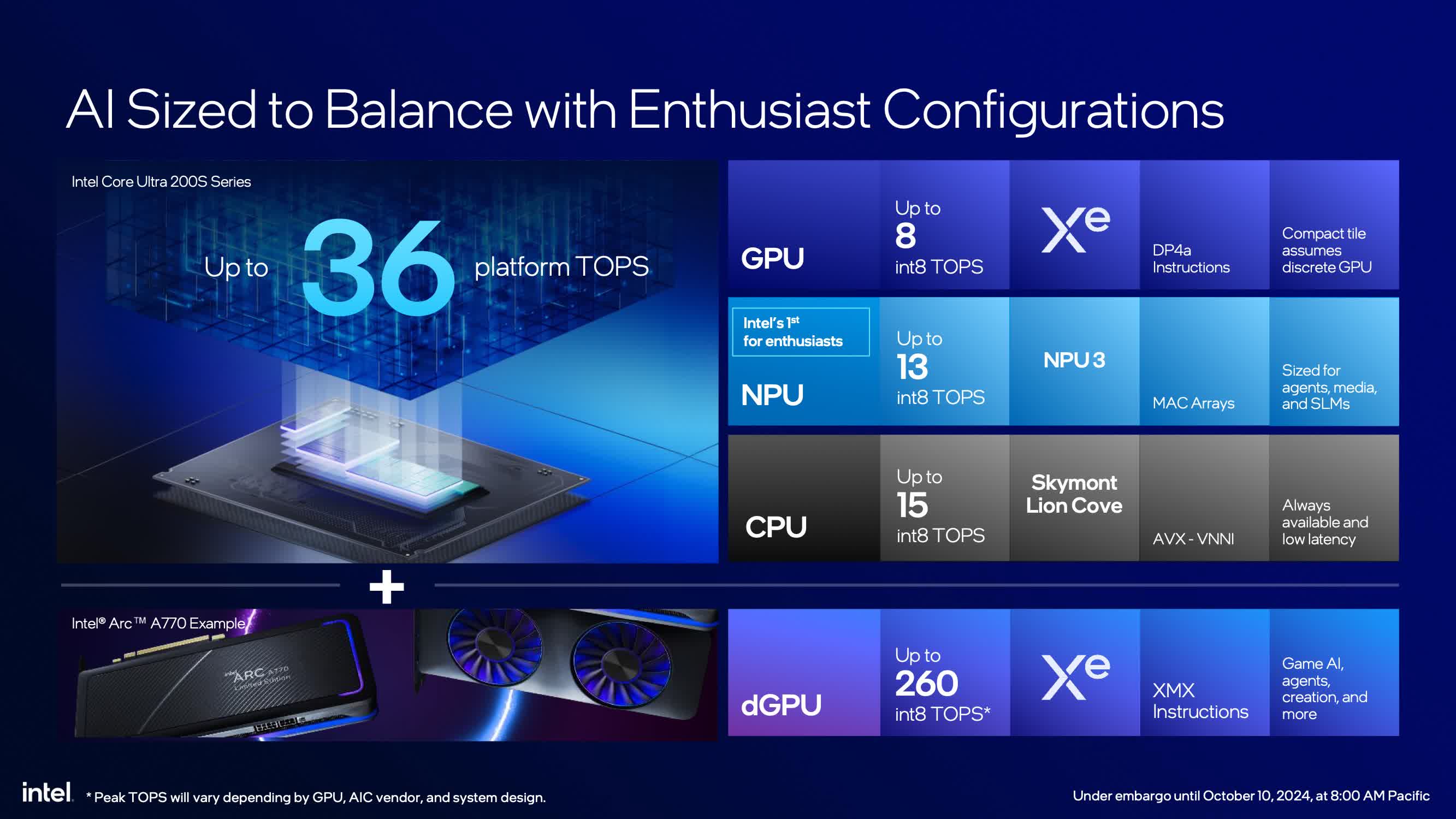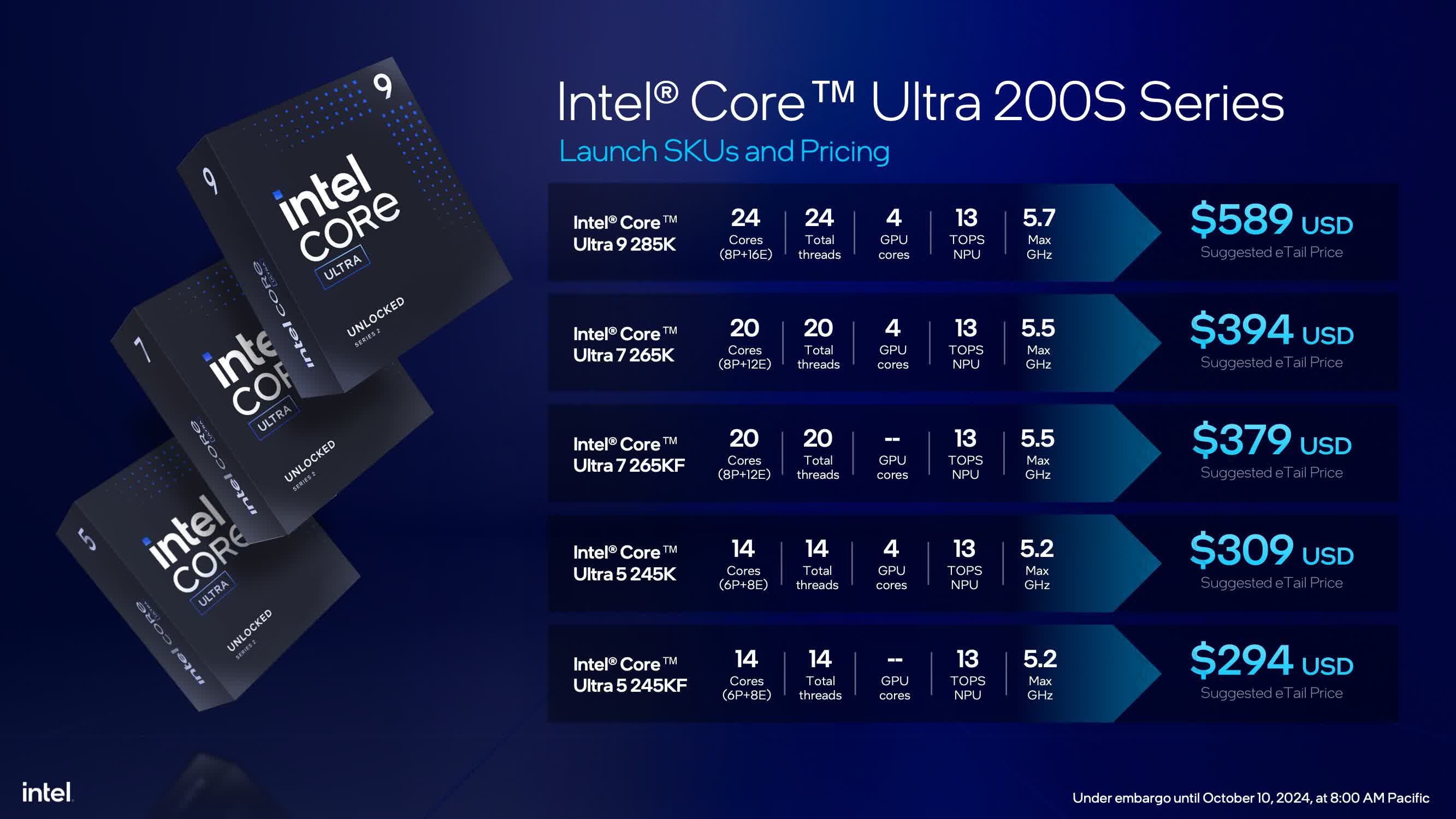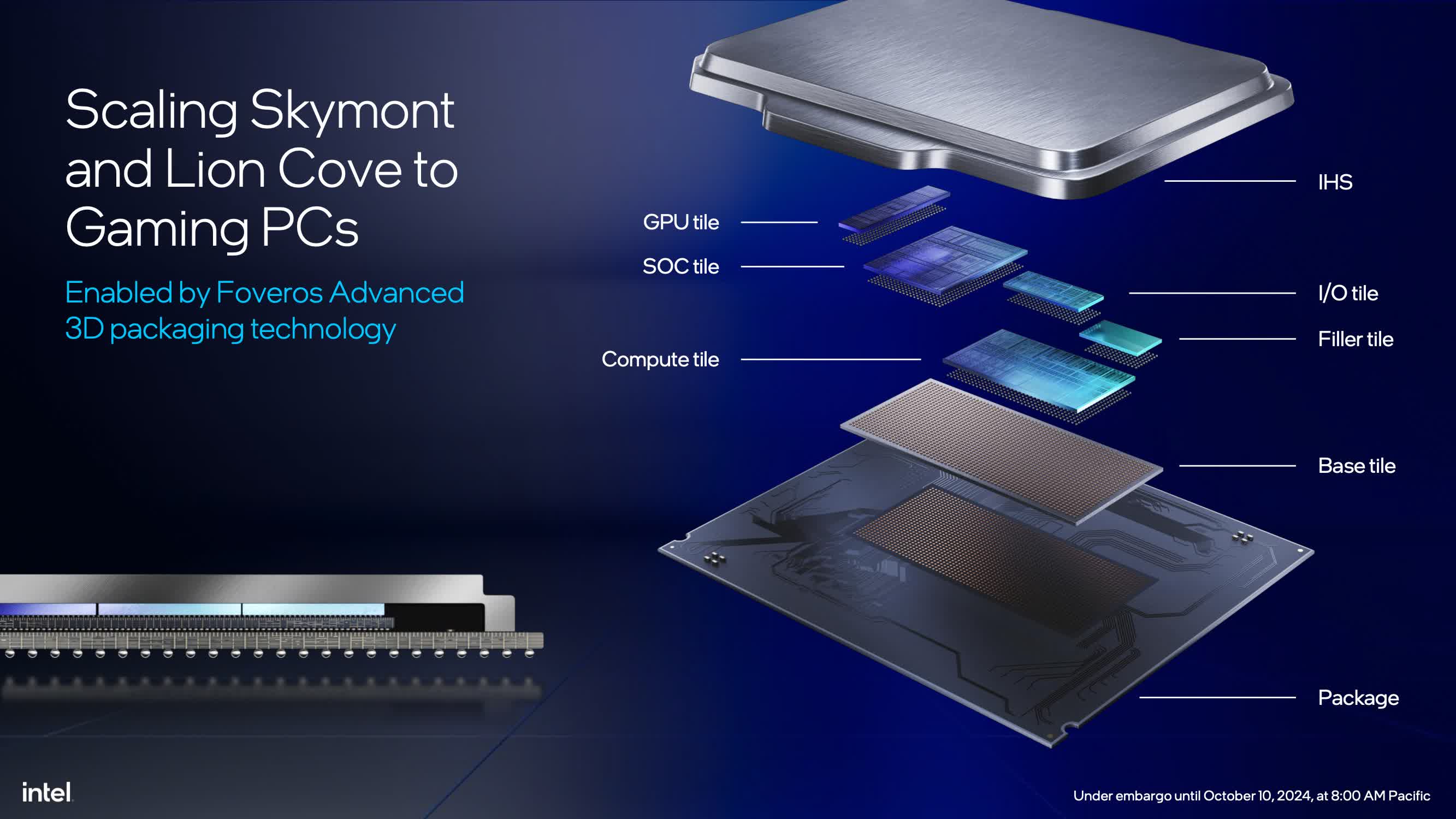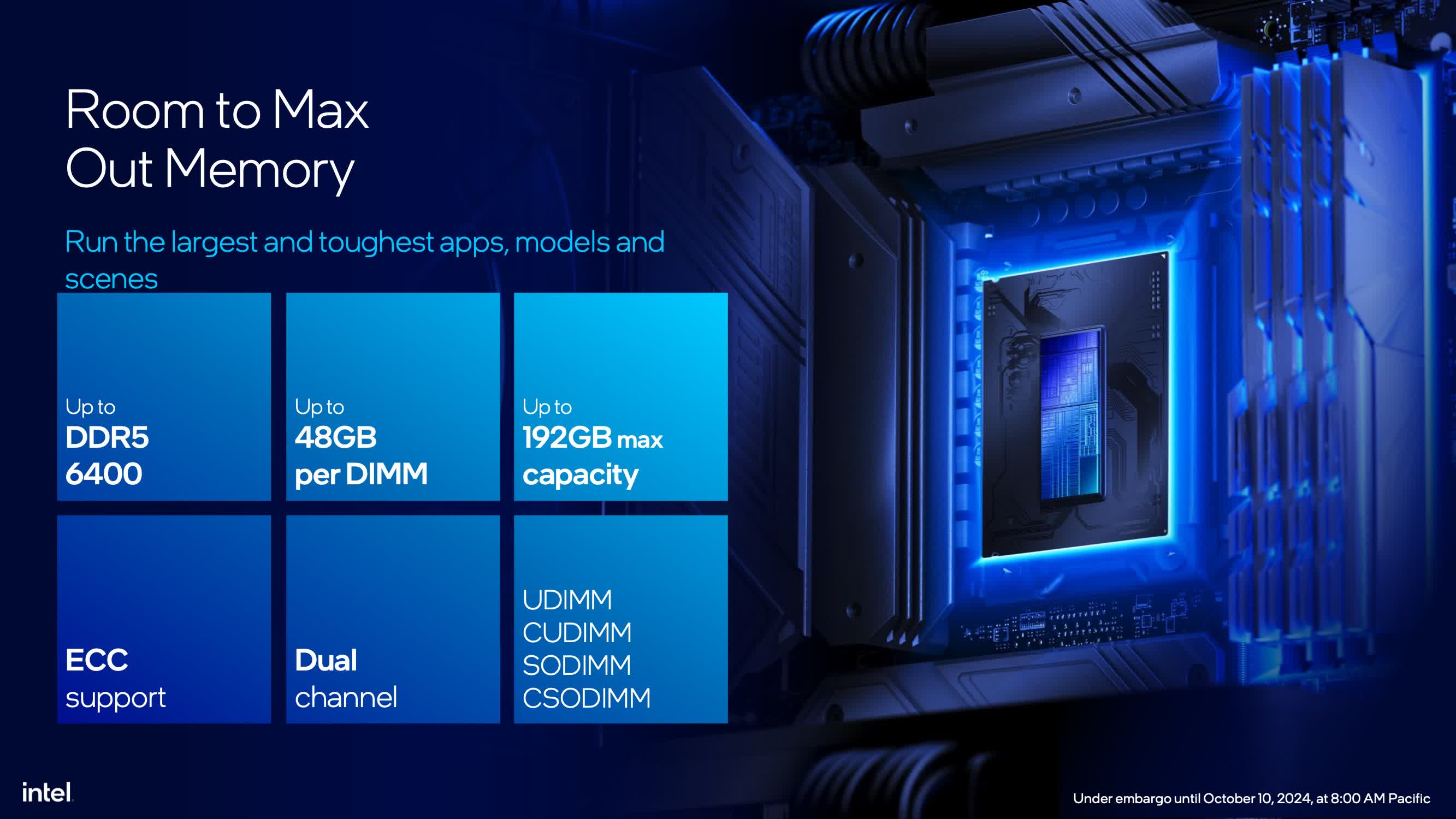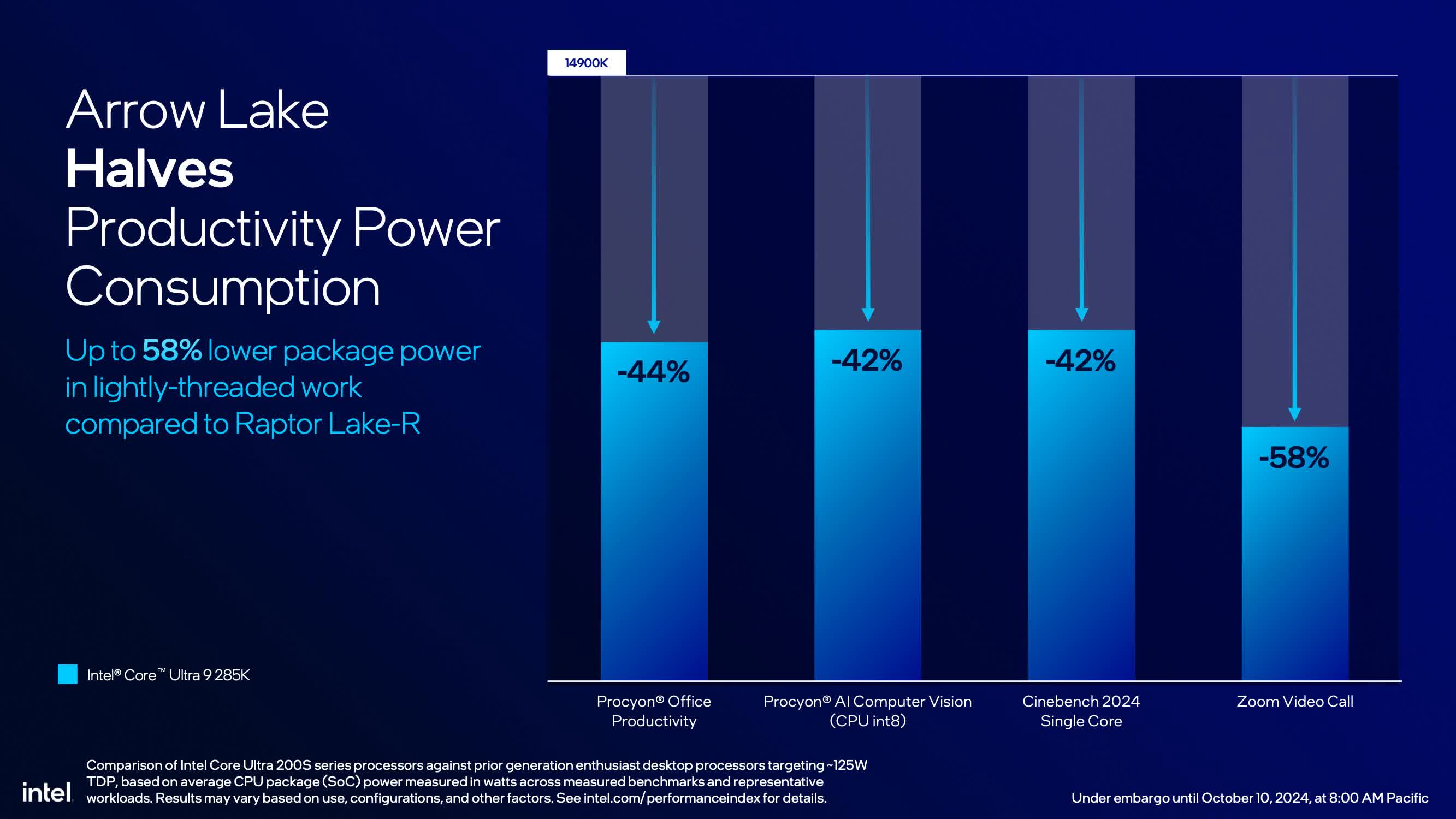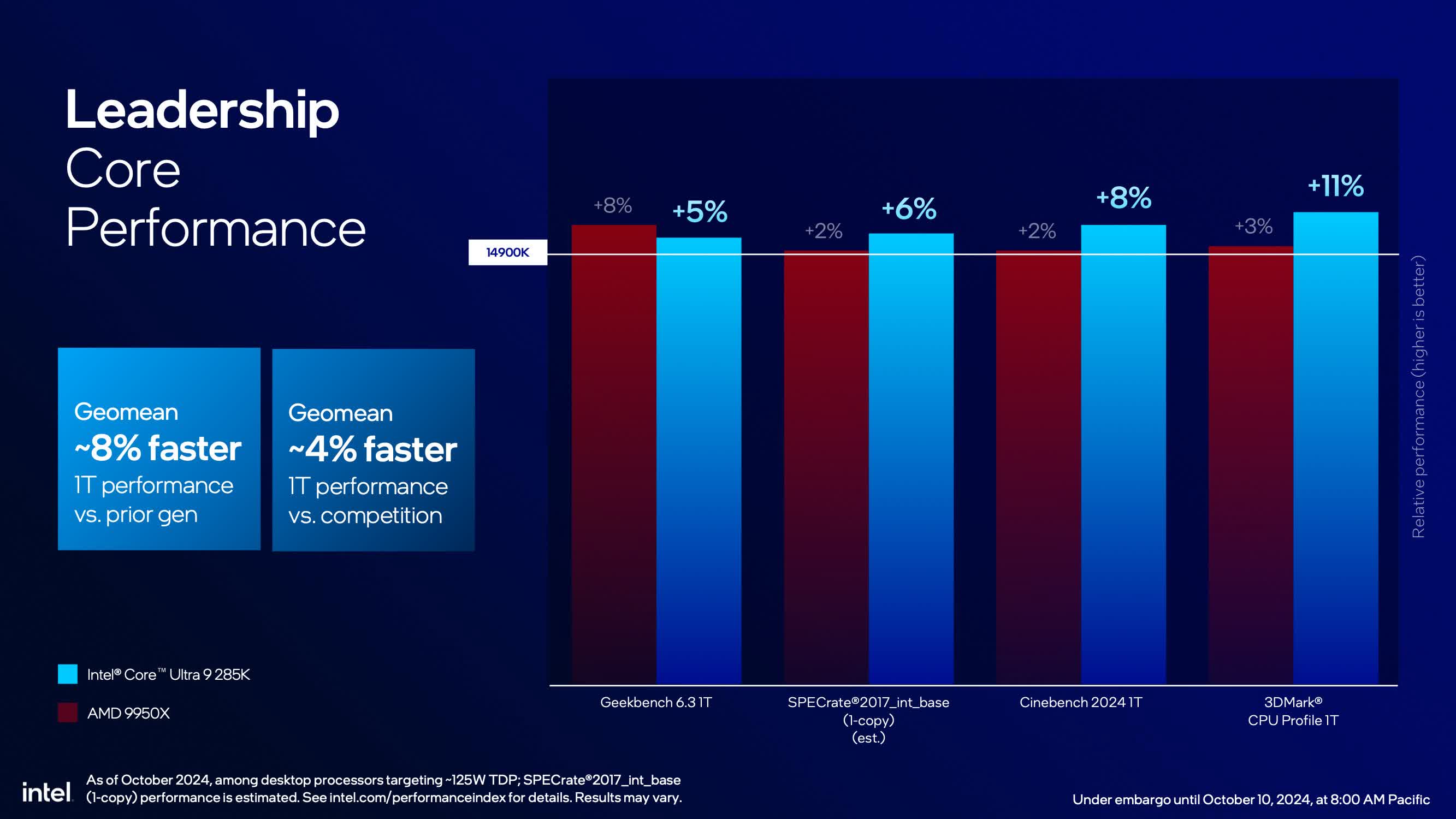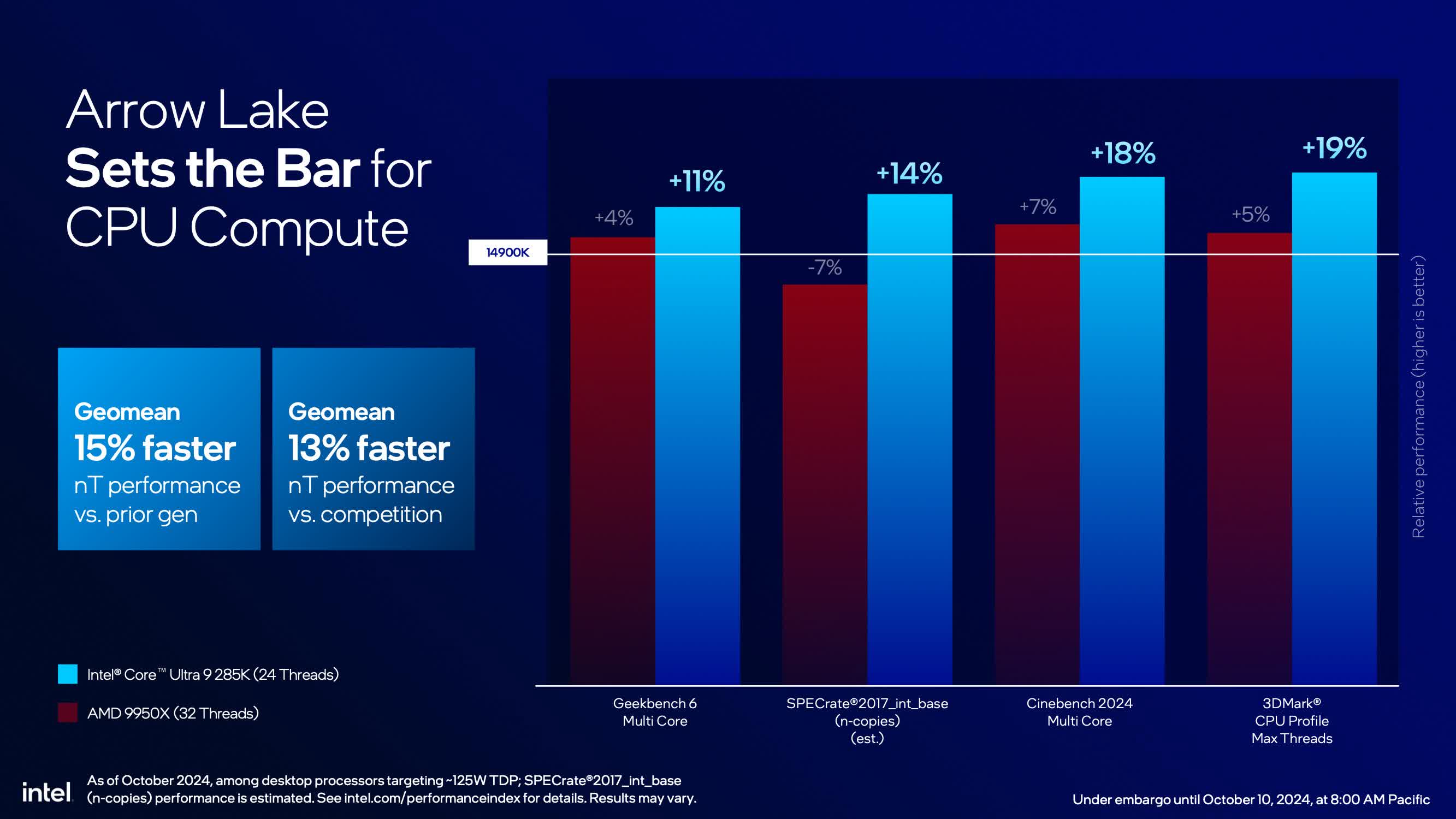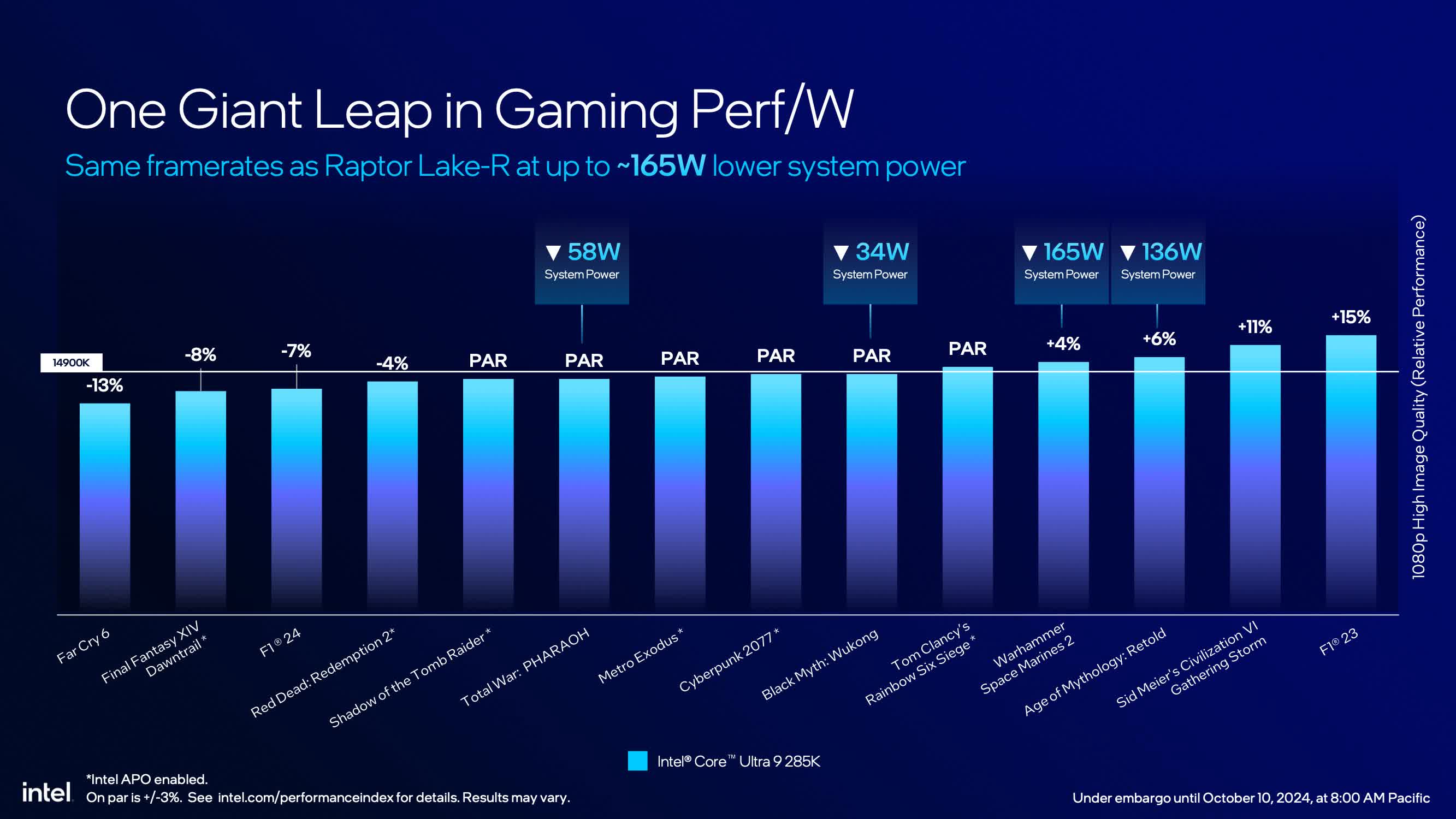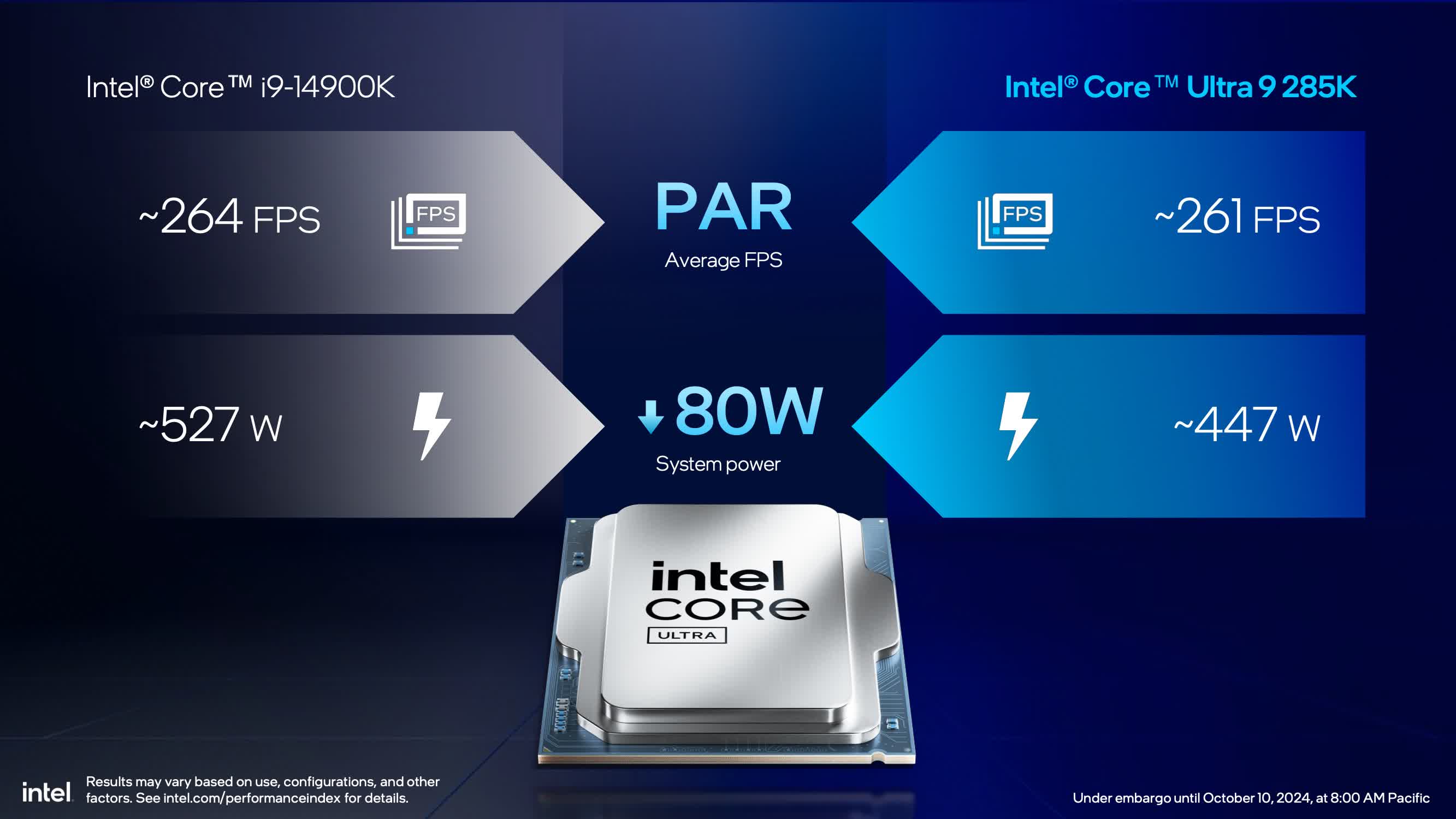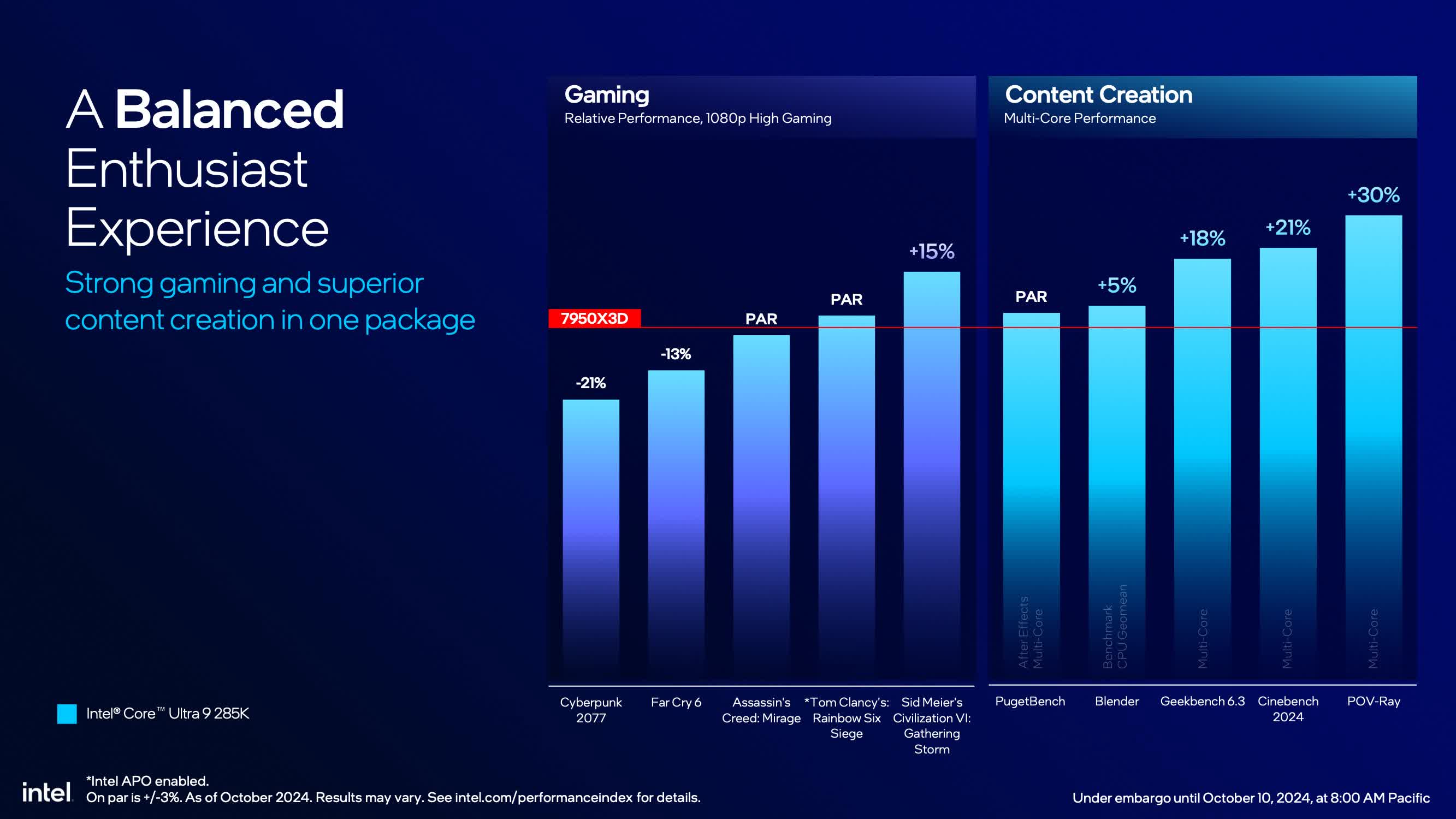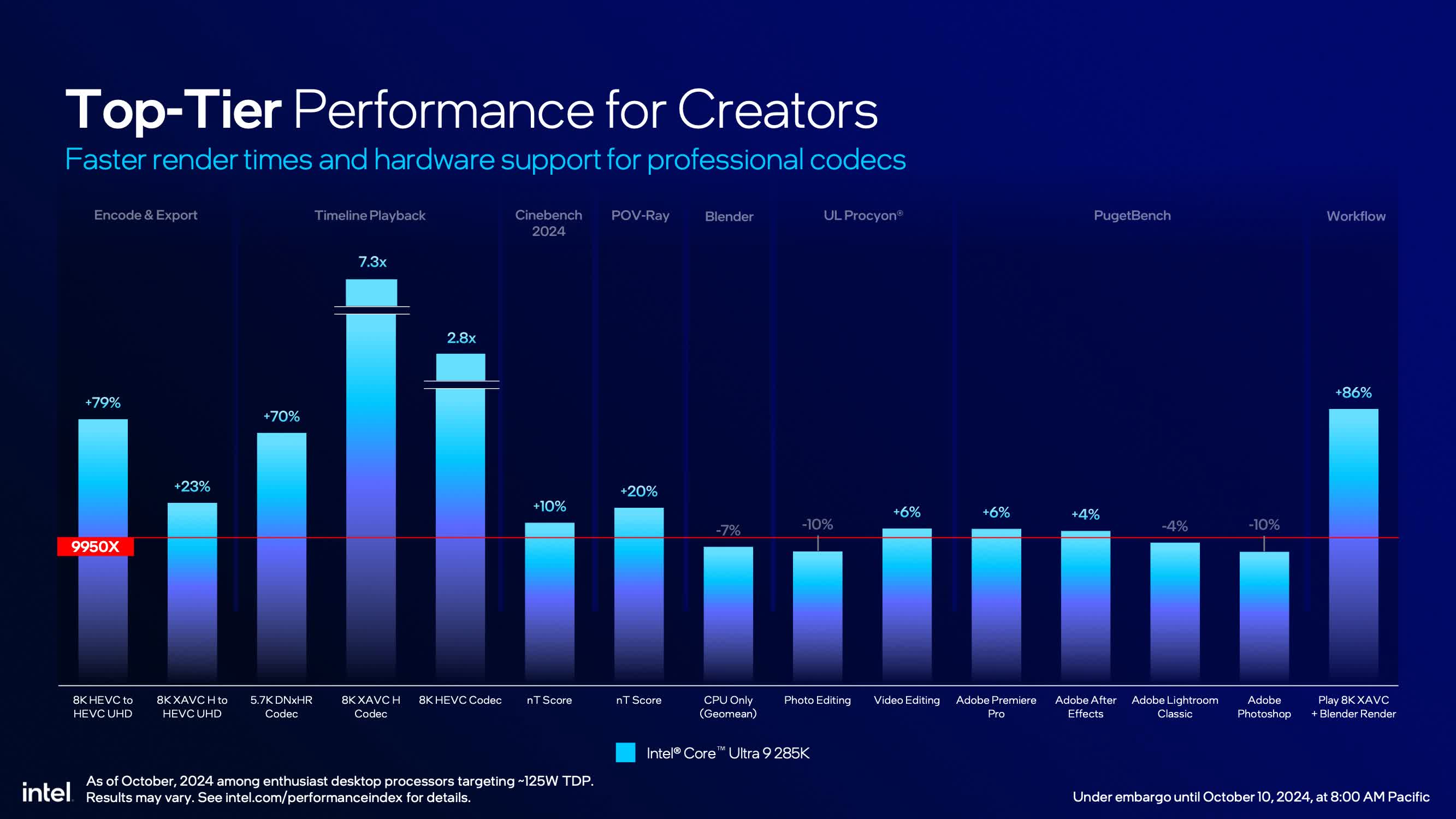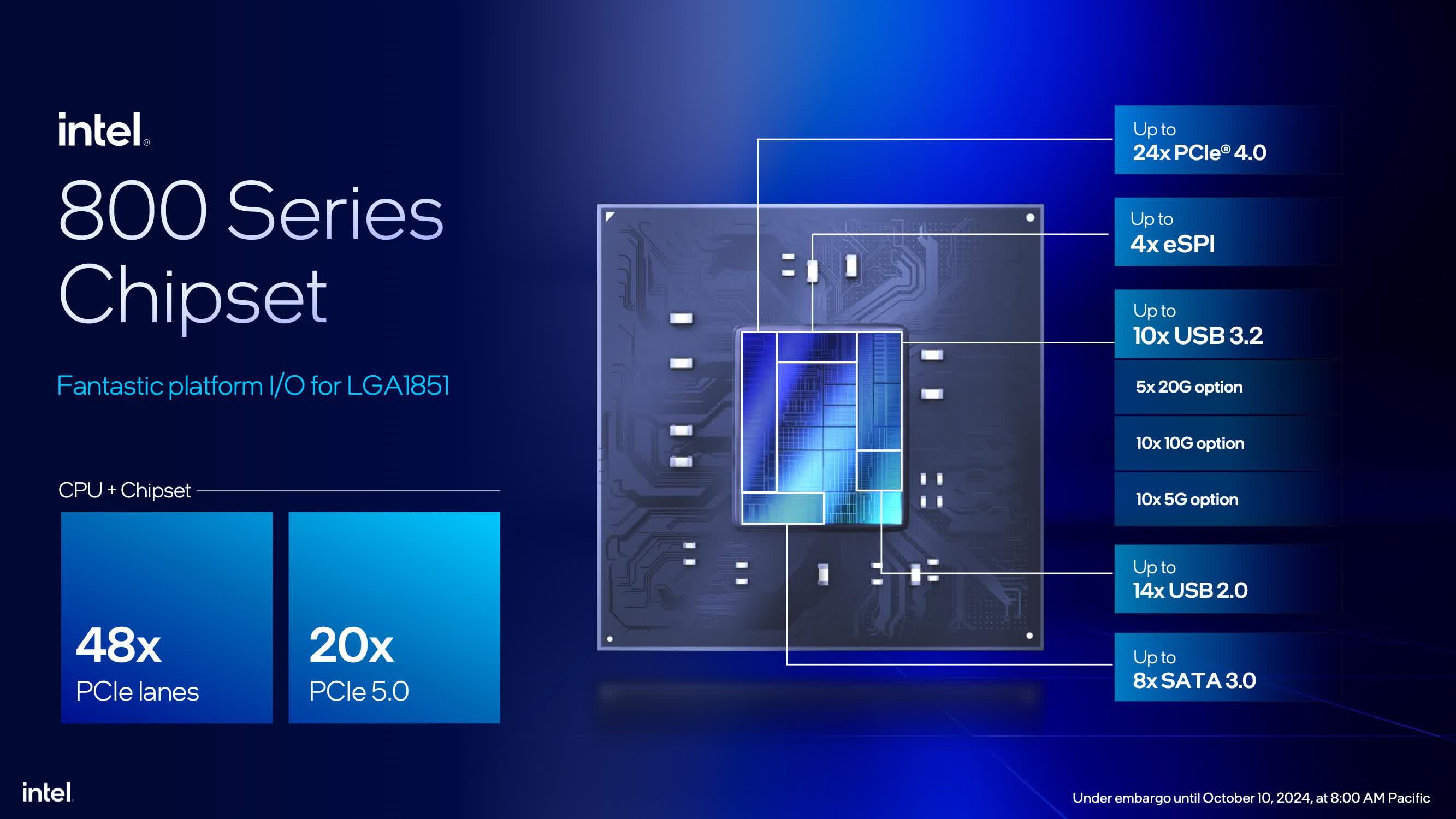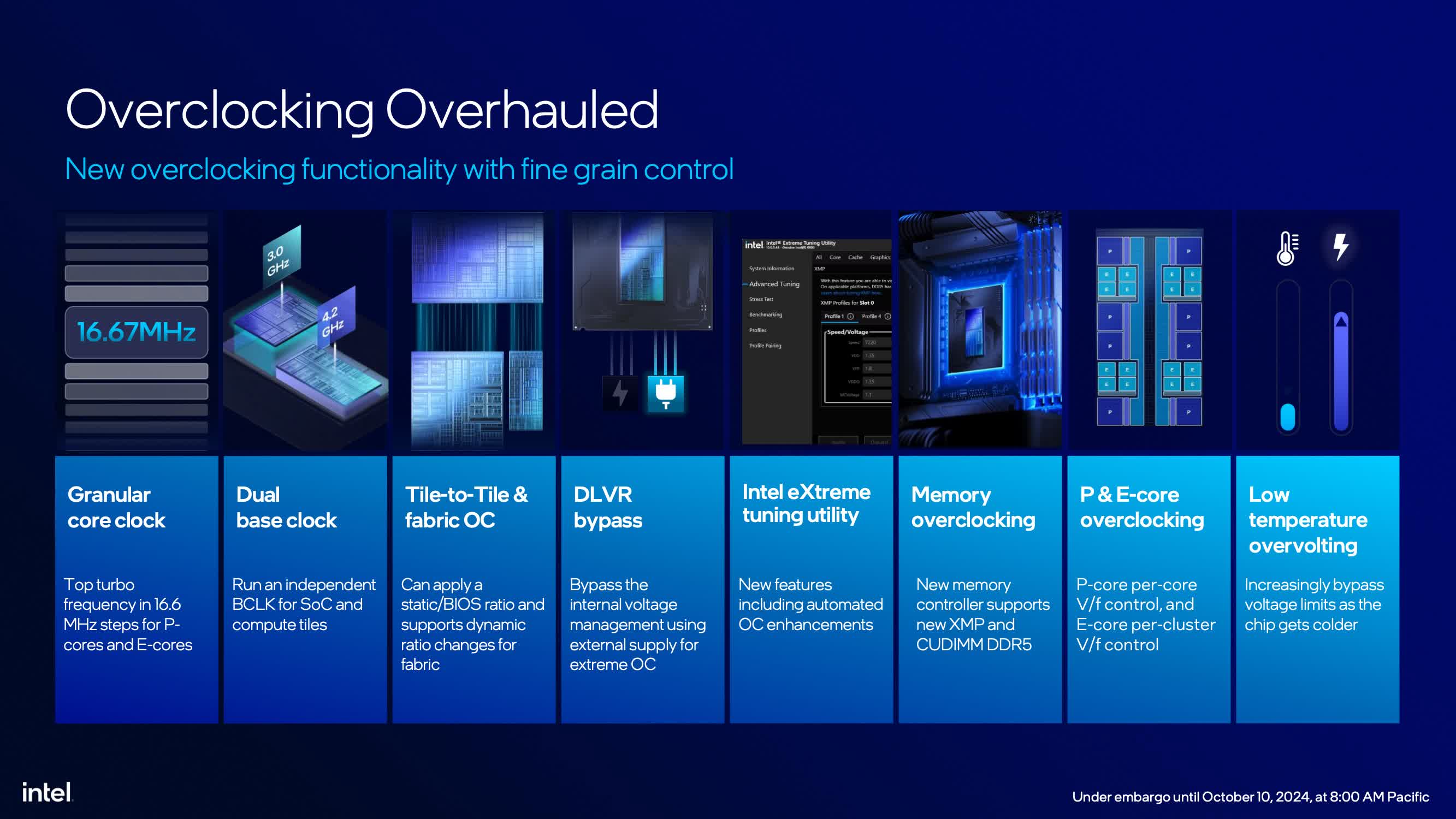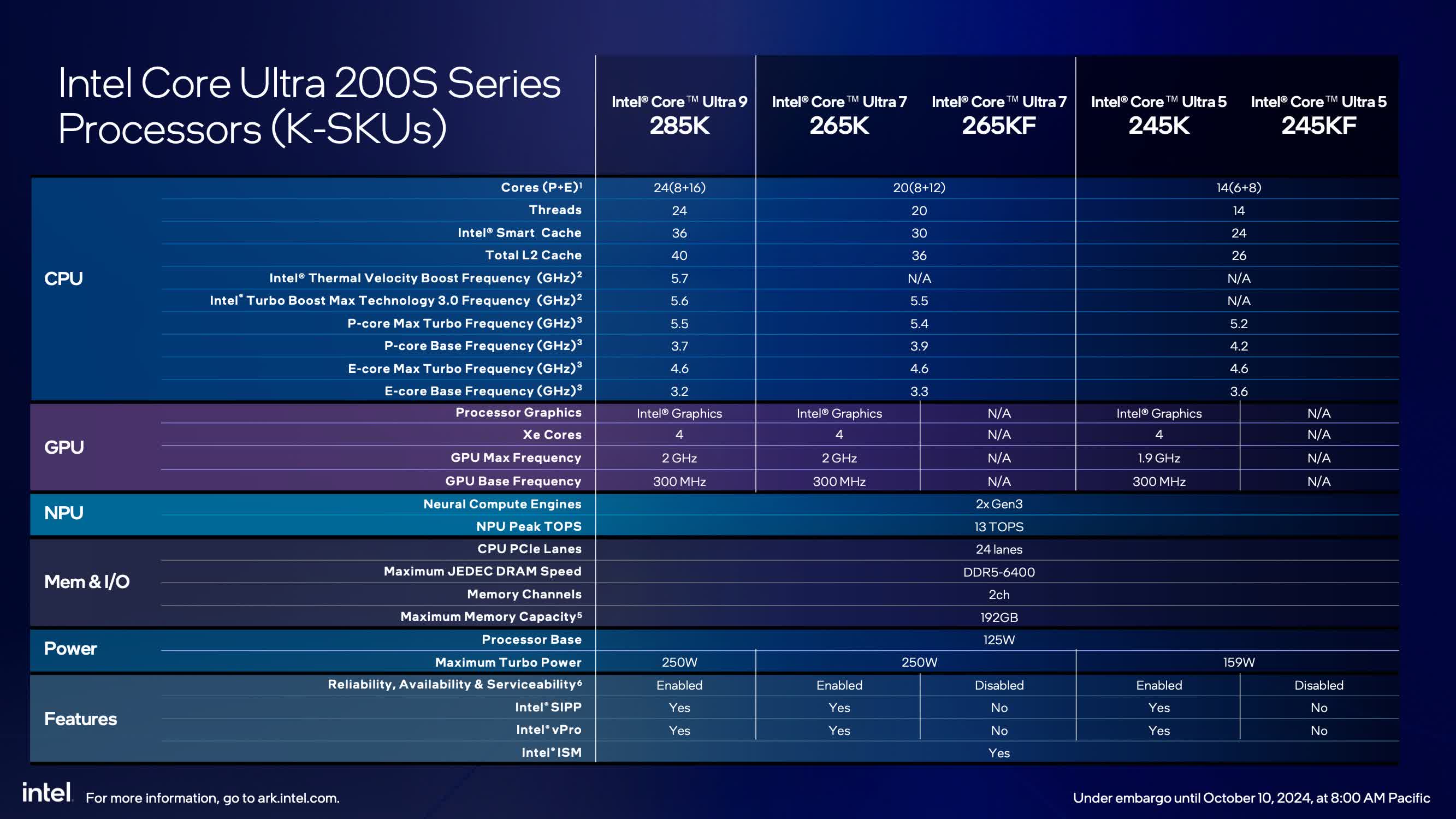Highly anticipated: Intel has announced the Core Ultra 200 CPU series for desktop PCs, also known as Arrow Lake, which introduces a brand new architecture. In Intel's words, this will set them up for the future of desktop processors. However, we have mixed feelings about what Intel has shown so far. While there are some improvements over the 14th-gen, it's questionable how competitive it will be – so let's dive into what Intel has revealed.
The Core Ultra 200 series is an architectural overhaul compared to Raptor Lake, used on the 13th and 14th gen Core series. The P-cores have been upgraded to the new Lion Cove architecture, which Intel claims is "the fastest performance core for desktop PCs." The E-cores have also been upgraded to the Skymont architecture, bringing the desktop design in line with Intel's recently announced Lunar Lake lineup for laptops.
Intel is claiming that the Lion Cove P-cores provide a 9% IPC uplift compared to Raptor Cove used in the 14th-gen. There are some interesting changes, such as the removal of hyperthreading, so now 8 P-cores come with 8 threads, instead of 16 like in previous generations. Other improvements include finer clock intervals, a wider core design, and an increase in L2 cache from 2MB to 3MB per core.
The changes to the E-cores are even more substantial, with Intel claiming a 32% IPC increase over Gracemont, the architecture used in Raptor Lake E-cores. These changes include a wider design, double the L2 cache bandwidth, and double the vector throughput. The 4MB of L2 cache is still used for each E-core cluster, with each cluster remaining at four cores.
The overall design still includes 36MB of L3 cache, accessible to both P and E-cores, contained within the compute tile. This is now a multi-tile design, instead of the monolithic approach seen with Raptor Lake, marking the first time Intel has brought this mobile design approach to desktop. However, the layout differs from the Lunar Lake laptop design, as Arrow Lake uses more tiles. It includes a compute tile, GPU tile, SOC tile, and I/O tile, all connected using Intel's Foveros advanced 3D packaging. In contrast, Lunar Lake only has two main tiles: the compute tile and the platform controller tile.
Arrow Lake is the first Intel desktop processor to be manufactured primarily by TSMC.
Arrow Lake is also the first Intel desktop processor to be manufactured primarily by TSMC. Intel has made some mobile tiles at TSMC for the last few generations, but with Arrow Lake all four main tiles are manufactured at TSMC. The compute tile is built on TSMC N3B, the GPU tile on TSMC N5P, and the SOC and I/O tiles on TSMC N6.
This gives Intel a node advantage for CPU cores compared to AMD's Zen 5, which uses TSMC N4 for its CCDs. Both companies use TSMC N6 for the I/O parts of their processors. The base tile and packaging processes, however, are still handled by Intel.
The Arrow Lake lineup
The Arrow Lake launch lineup includes five processors: the Core Ultra 9 285K, which is the flagship, followed by the Core Ultra 7 265K and 265KF, as well as the Core Ultra 5 245K and 245KF. As with previous generations, the K indicates an unlocked CPU, and KF indicates an unlocked CPU without integrated graphics. The iGPU in Arrow Lake features four Xe-LPG cores.
The fully unlocked Arrow Lake configuration comes with 8 P-cores, 16 E-cores, and 4 GPU cores, which is what you get with the Ultra 9 285K. In total, you get 24 threads due to the lack of hyperthreading. With the Ultra 7 265K, this drops to 8 P-cores and 12 E-cores, while the Ultra 5 245K has 6 P-cores and 8 E-cores.
These configurations are identical to the 14th-gen K-SKU Core i9, i7, and i5 parts, meaning Intel is relying entirely on architectural improvements to deliver performance gains with Arrow Lake.
One of the bigger changes is the clock speeds. Across the board, Arrow Lake is clocked lower than Raptor Lake. The 285K drops to 5.7 GHz, down from 6.0 GHz on the 14900K. The 265K falls to 5.5 GHz, down from 5.6 GHz on the 14700K, and the 245K drops to 5.2 GHz, down from 5.3 GHz on the 14600K.
For the flagship model, this amounts to a 5% reduction in peak clock speed, although it's just a 2% drop for the Ultra 5 model. However, Intel is counting on the 9% IPC increase to deliver better performance than Raptor Lake, making P-cores only a few percent faster overall.
E-core frequencies, on the other hand, have improved. All models now boast a 4.6 GHz max E-core frequency, up from 4.0 to 4.3 GHz on Raptor Lake. Base clocks are also higher across both P-cores and E-cores.
In terms of memory support, Intel has made significant improvements over Raptor Lake. Base memory speeds now hit DDR5-6400, and Intel is claiming DDR5-8000 as the new sweet spot, offering around 5% more performance than DDR5-6400. However, with the I/O tile on a separate piece of silicon compared to the monolithic Raptor Lake, it'll be interesting to see how memory latency fares with this new design. This could be one area where performance doesn't move forward as expected.
Power consumption is a major talking point with Arrow Lake, as Intel is claiming much better efficiency. However, there's a catch: while Intel claims performance and efficiency gains relative to Raptor Lake, you won't get both at the same time.
Arrow Lake CPUs are still rated at 125W of "base power" (TDP), with maximum turbo power reaching 250W for the Ultra 9 and 7 models, and 159W for the Ultra 5. This is a modest 3W reduction in turbo power for the top-tier parts relative to Raptor Lake, and a 22W reduction for the Ultra 5 compared to the 14600K.
Intel has told us that the default motherboard configuration for Arrow Lake will be PL1=PL2=250W for the top models and PL1=PL2=159W for the Ultra 5 K-SKUs. This is the "Performance" profile, meaning that despite the claims of improved power consumption, the default maximum power draw will be similar to Raptor Lake when using Intel's "recommended" and now "default" settings.
Performance and Power
That being said, there are still efficiency gains. Intel is claiming half the power consumption of 14th-gen for lightly threaded applications that don't require all cores. For instance, power consumption is reduced by 42% for Cinebench 2024 single-core and 44% for Procyon Office Productivity. In gaming, which typically doesn't use the full power of the CPU, Intel is claiming an average reduction of 73W when comparing the 285K to the 14900K, with some reductions exceeding 100W.
For multi-core workloads like Cinebench 2024, Intel claims they can match the performance of the 14900K at half the power, but only when manually configuring the BIOS to lower power consumption.
For multi-core workloads like Cinebench 2024, Intel claims they can match the performance of the 14900K at half the power, but only when manually configuring the BIOS to lower power consumption. By default, the 285K and 14900K will both target 250W, with Arrow Lake offering a performance boost. However, if you lower the 285K to 125W, it will perform similarly to the 14900K at 250W, with an even greater efficiency gap at lower power levels.
This is where some of Intel's slides can be a bit deceptive at first glance. They suggest up to a 19% increase in multi-thread performance and up to a 58% reduction in power for lightly threaded applications, but you won't achieve these improvements simultaneously. You'll have to choose between performance and efficiency in heavy multi-thread workloads, and you'll need to manually lower PL1 to 125W in the BIOS to see these efficiency gains.
For Arrow Lake's best-case performance, Intel claims a 9% IPC gain on P-cores and a 32% gain on E-cores. While P-cores have a lower frequency, E-cores are clocked higher. Overall for heavy multi-threaded workloads, Intel is claiming 15% better performance for the 285K vs 14900K, and this is with Arrow Lake set to PL1=PL2=250W and Raptor Lake set to PL1=PL2=253W – in fact, this is the configuration Intel used for the vast majority of their testing. However that's the geomean of just four benchmark results they ran – there's no additional testing folded into that number.
As for single-threaded performance, Intel is claiming an 8% gain for the 285K vs 14900K, and this allows their part to outperform the AMD Ryzen 9 9950X by 4% in their single-thread testing. For mutli-threaded performance, Intel are also claiming a 13% lead over the 9950X. In Intel's testing, they found the 9950X to be a little ahead of the 14900K generally, and that's also what we found in our benchmarking, so what Intel is claiming in these charts should be seen in independent testing. In fact, Intel is so confident this will be the case that they made a joke about this in their presentation, clearly in reference to the issues AMD had with benchmark claims that couldn't be replicated.
These aren't earth shattering margins, but for productivity tasks Intel is claiming they will have the fastest desktop processor with the Ultra 9 285K. We didn't see any performance claims for the lower tier models which is a little strange as with the given hardware specifications I would expect the Core Ultra 5 245K with 6P and 8E cores to handily outperform the Ryzen 5 9600X in multi-thread workloads, which is already the case with the Core i5-14600K versus 9600X.
Gaming performance
The elephant in the room here is gaming performance. While Intel claims parity between the 285K and the 14900K in gaming, based on a 31-game average, they also acknowledge that in some titles, Arrow Lake is slower. This could be due to the memory configurations used during testing, as the 14900K was paired with DDR5-5600, and the 285K with DDR5-6400. Intel suggests that Arrow Lake will perform best with DDR5-8000, offering around a 5% gain over DDR5-6400.
The qualifier to this is that while both CPUs are tested using equivalent PL1=PL2 power settings, Intel uses base memory configurations for each part. So, the 14900K is equipped with 32GB of DDR5-5600 CL28 memory, and the 285K is using 32GB of DDR5-6400 CL32 memory. We found in our 13th-gen memory scaling testing that Raptor Lake gains a couple of additional percentage points using DDR5-7200 CL34 memory versus DDR5-5600.
But then Intel also claims the sweet spot for Arrow Lake is DDR5-8000 with an approximate 5% gain over DDR5-6400 – basically, performance could go either way when testing the optimal configuration for both parts, and with such tight margins between them, these details will matter in determining which is overall faster.
Intel claims this level of performance gives the 285K parity with the Ryzen 9 9950X in gaming, using a 31-game geomean and a 14-game sample. However, in a five-game sample, they showed the 285K losing on average to the Ryzen 9 7950X3D while outperforming it in productivity tests. In these situations, they used DDR5-5600 CL28 memory for the 9950X since DDR5-5600 is the base memory for Zen 5, while DDR5-5200 CL28 was used for the 7950X3D, again the base memory for that platform.
In our day-one Ryzen 9 9950X review, we found that the 14900K was 7% faster than the 9950X across a 13-game sample using optimal memory, but in Intel's testing here, they suggest the 14900K and 9950X are more evenly matched. Based on these claims, this would make the flagship Arrow Lake processor better than the current fastest non-X3D Zen 5 CPU for gaming, though as always, you should take these numbers with a grain of salt since they are first-party benchmarks.
The issue for Intel will be the X3D processors. Our testing found the 7950X3D and 14900K to be neck and neck, with Intel claiming the 285K is slower than the 7950X3D in gaming. But the big issue is that the 7800X3D is generally 5-10% faster than the 14900K across a large sample of games.
With no real claimed performance improvement for the 285K over the 14900K, it's unlikely that Arrow Lake CPUs will offer the best gaming performance on the market, whether from the 7800X3D or the upcoming 9800X3D. It will come down to individual battles to see whether parts like the 265K can outperform a 9700X, for example.
In general, though, Intel is claiming Arrow Lake's gaming performance has not kept up with gains seen in productivity, where performance is supposed to be 8 to 15 percent better. This is a similar story to AMD with Zen 5, although this time Intel is being upfront that Arrow Lake is not a step forward for gamers.
There are a couple of other tidbits in here too. Intel claims Arrow Lake is easier to cool, with an average of 13 degrees Celsius lower package temperatures while gaming compared to the 14th-gen on a 360mm AIO liquid cooler. This is likely due to reduced power consumption while gaming, so we'll have to see how temperatures fare in all-core workloads.
Intel also claims the Core Ultra 7 265K is about 5% slower than the 14900K for gaming, which is probably going to put it around the performance of the 14700K. In our testing, the 14700K is about 4% slower than the 14900K.
A new platform: LGA1851
Arrow Lake will be on a new platform, LGA1851, using 800 series chipsets. This platform is a modest upgrade over LGA1700, dropping support for DDR4 and increasing PCIe capabilities. The CPU now supports 20 lanes of direct PCIe 5.0 connectivity, up from 16, in addition to four lanes of PCIe 4.0.
This means Arrow Lake now supports both the primary x16 slot and the primary M.2 slot over PCIe 5.0, whereas the previous generation capped at PCIe 4.0 for the primary M.2. There's also dual Thunderbolt 4 connectivity directly on the CPU.
The 800 series chipsets, particularly the Z890, will support up to 24 additional PCIe 4.0 lanes, replacing the previous split of 20 PCIe 4.0 and 8 PCIe 3.0 lanes on Z790. USB, SATA, and Wi-Fi support remains the same. Relative to AM5 on X870E, Arrow Lake with Z890 will have slightly less PCIe capacity directly out of the CPU, but the chipset supports double the amount of PCIe 4.0 connectivity and more USB connectivity as well.
The big disappointment from this presentation is that Intel is making no claims or promises of future CPU architecture support on LGA1851 and refused to answer our questions about it, saying they didn't have details to share on future products.
With no promises to buyers that LGA1851 will offer platform longevity, it's safe to assume this is a typical Intel platform with, at most, two generations of CPU support. In fact, some recent rumors have suggested there might only be one CPU generation on this platform, which would be incredibly disappointing, though this remains unconfirmed.
The takeaway is that there is no long-term support for this platform. In the best case, LGA1851 will offer similar future CPU support to AM5, where AMD is expected to provide at least one additional CPU generation. In the worst-case scenario, AM5, with promised support until 2027+, could offer greater platform longevity than LGA1851. As usual, Intel buyers will enter a new CPU generation with no expectation that their motherboard will be useful for future CPU upgrades, and there's no key platform advantage compared to AM5, despite the new platform and architecture.
Pricing
Arrow Lake will be available on October 24 at roughly the same prices as Intel's 14th-generation processors. So, the 285K will be priced at $589, the 265K at $394, the 265KF at $379, the 245K at $309, and the 245KF at $294. Some models are $5 to $15 cheaper than Raptor Lake Refresh, but nothing substantial enough to shake up Intel's usual pricing structure.
Relative to AM5 processors, this pricing isn't particularly exciting. The 285K will compete with the 9950X at $650 and the 7950X, currently priced around $515. Intel is claiming that their new Arrow Lake flagship should outperform both of these parts in productivity, but its value doesn't seem much better than the 7950X, which has been available between $500 and $550 all year.
The nearest competitors to the 265K are the Ryzen 7 9700X at $360 and the Ryzen 9 7900X, currently at $425. If its application performance beats the 14700K, this part would be a good value compared to the 7900X, which is slower than the 14700K. The 245K will compete against the Ryzen 5 9600X at $280 and the 7700X at $250. Depending on how the 245K compares to the 14600K, this part might be okay for application performance.
Where Intel might struggle with this lineup is gaming. Based on Intel's claims, Arrow Lake's gaming performance should land between base Zen 4 models and the 7800X3D, with the 7800X3D outperforming it. The problem is that you can buy a Ryzen 5 7600 for under $200, whereas the cheapest Arrow Lake part announced so far is $294.
Based on Intel's information so far, this doesn't seem like an impressive deal for gamers, and for those seeking the best gaming performance, the 7800X3D and its upcoming successor will likely deliver better performance at a lower price than Intel's Arrow Lake flagship. Whether these parts are worth buying for gaming will depend on the margins and where parts like the 245K end up.
Overall, Intel's Arrow Lake announcement is pretty much what we expected. As we've discussed before, Intel's return to leadership in desktop CPUs will be a multi-generation journey. Making a new generation both significantly faster and more efficient at once was always going to be a challenge, and with Arrow Lake, it seems Intel has focused on power consumption over performance. In Intel's presentation, they even described this generation as a reset that sets them up for the future.
With all that in mind, it's hard not to be disappointed with what Intel revealed. While Intel is claiming application performance has improved slightly compared to Raptor Lake, and they believe the Core Ultra 9 285K will be the fastest productivity CPU, stagnating gaming performance is not ideal.
We guess Arrow Lake is positioned to be a more efficient gaming CPU, but whether that makes it worth buying over AMD's Zen 4 and Zen 5 is questionable. We're still uncertain whether it will outperform Zen in gaming power use.
There's two things Intel could have done to make Arrow Lake more attractive to buyers...
Intel could have done two things to make Arrow Lake more attractive to buyers, given the CPU hardware isn't faster in every key area, but they did neither. One would be providing a strong commitment to future CPU generations on the LGA1851 platform, assuring buyers they could upgrade to more powerful parts in the future.
Intel didn't do this and refused to comment on platform longevity.
The other option would have been to make Arrow Lake very affordable, appealing to customers based on value, but Arrow Lake uses the same pricing structure as 14th-gen, so they're not pursuing that route either.
Unless there are big positive surprises in terms of final performance – and we'll have our reviews for you around launch on October 24 – Intel hasn't shown a processor today that will significantly impact the CPU market.
We don't think they've presented a strong case that Arrow Lake offers substantial advantages over Zen 5, but they have claimed improvements relative to 14th-gen Raptor Lake. Whether that's enough to earn a recommendation – well, you'll have to check our review to find out.

